Hot peppers are most easily grown from transplants. Grow hot chili peppers in the warmest, frost-free time of the year.
Start hot pepper seed indoors 8 to 10 weeks before the date you intend to set peppers into the garden.
Peppers can be seeded in the garden or transplanted out 2 to 3 weeks after the last frost in spring after the soil temperature has risen to at least 65°F. Peppers are tender perennials that are grown as annuals. Peppers grow on compact erect bushes 1½ to 2 feet tall. The fruit follows a single flower growing in the angle between the leaf and the stem. Hot peppers can range in length from 1 to 7 inches long and in color from green to red to gold and yellow.
Related articles:
- Five Ways to Cook and Serve Sweet Peppers
- Five Ways to Cook and Serve Chili Peppers
- Pepper Seed Starting Tips
- Six Tips to Grow Peppers for Flavor
- 7 Tips for Growing Peppers in Pots
- How to Harvest and Store Peppers
- How to Grow Sweet Bell Peppers
- How to Plant and Grow Hot Peppers
- Pepper Growing Problems Troubleshooting
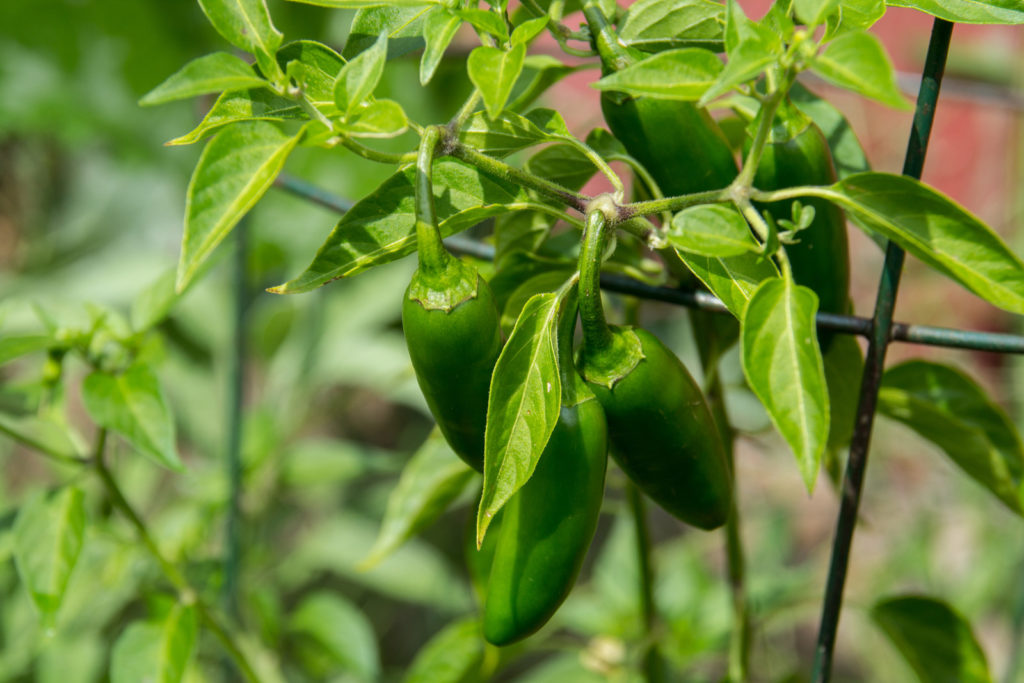
Hot peppers grow best where the air temperature ranges from 70° to 95°F. Hot peppers mature in 60 to 95 days.
Hot peppers vary greatly in spiciness. Choose peppers and the number to plant according to how you plan to use them.
Why hot peppers are hot
Slice open a hot pepper and you will see tiny blisterlike sacs on the inner wall of the pepper. These sacs contain capsaicinoids or organic chemicals. Capsaicinoids make peppers hot.
The more sacs you see on the inside of a pepper the hotter the pepper will be. When a pepper is cut or handled roughly the sacs break and splash onto the pepper’s seeds and inner walls. That’s when you taste the hotness of a pepper.
The best-known capsaicinoid is capsaicin. Capsaicin is so potent that the average person can detect its presence even when it is diluted in water to 10 parts per million.
How hot pepper heat is measured
The hotness or pungency of a pepper is measured in Scoville Heat Units (SHU). American pharmacologist Wilbur Scoville invented this scale in 1912; it is basically a taste test. Scoville asked five people to taste diluted capsaicinoids from peppers; if the tasters could still taste the hotness of a pepper when 1 part of the pepper was diluted with say 10,000 parts water, then that pepper would be rated 10,000 on the SHU. A habañero pepper is rated up to 500,000 SHU.
Good Products at Amazon for Growing Peppers:
- Espoma Garden Tone 3-4-4 Fertilizer
- Epsom Salt Plus Plant Nutrients Magriculture
- Tomato Grower’s Answer Book
- Neem Bliss 100-% Cold Pressed Neem Oil
- Safer Brand Insect Killing Soap
- Monterey BT Caterpillar Killer
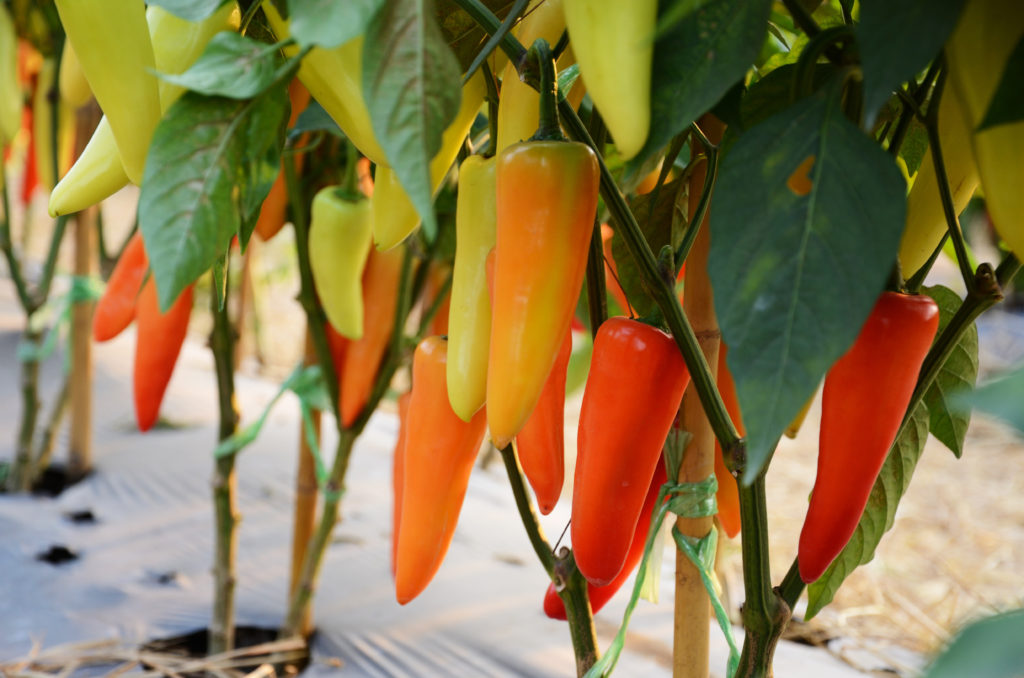
Hot pepper varieties to grow
Here are hot peppers–also called chili peppers–you can grow in the garden:
Mildly hot peppers (from 100 to 2,500 SHU)
- Anaheim. Mild to moderately hot. Long, tapered, pointed fruit; 7 to 8 inches long, 1 inch wide. Light green turning crimson red when ripe; medium to thick-walled. Use for stuffing when red. The plant grows to 30 inches.
- Ancho (called Poblano when picked green). Mildly pungent to hot (1,000-1,500 SHU). Large, conical fruit to 5 inches long, to nearly 4 inches wide; dark green turning red when ripe. Use in chili rellenos. The plant grows to 36 inches tall.
- Big Jim. Medium hot (500-1,000 SHU). Large to very large fruit to 9 inches long, 2 inches wide at should tapers to blunt end; medium-green turning red when ripe. Use fresh, dried, or canned.
- Hungarian Yellow Wax (also called Hungarian Long Wax). Very pungent. Slightly tapered fruit to 7 inches long, 1½ inches in diameter. Waxy yellow turning red at maturity; medium thick-walled. For canning and pickling. Upright plant to 24 inches. 62 days. Open-pollinated.
- Italian White Wax. Mild when young, very pungent at maturity. Tapered, point fruit to 3 inches long ½ inch in diameter; pale yellow turning red at maturity. Upright plant to 40 inches tall. Open-pollinated.
- Caloro. Pungent. Similar to Santa Fe Grande. Compact plant to 24 inches tall. Prolific fruit. Widely adapted and grows in difficult climates. Good for containers. Pickle or use as a sandwich garnish or as an appetizer.
- Mexi Belle. Mildly hot, pungent ribs (100-500 SHU). Bell pepper shape, medium-sized 3 to 4 lobes; medium green turning red when ripe; thick walls. Compact plant 14 to 30 inches high. Will produce 10 to 20 pods. Widely adapted. All America Selection. Matures in 70 days. Stuff or add to stir-fries.
- Mulatto. Pungent. Pods are 4 to 6 inches long, and 3 inches wide tapering to a blunt end. The plant grows to 36 inches tall. Matures to dark chocolate brown. Set fruit best in cool temperatures. Stuff like ancho or used dry to make mole sauce.
- New Mexico #6. Mildly hot and flavorful. Anaheim type. Tapered fruit to 6 inches long, 1½ inches in diameter; green turning red when ripe. Use for chili rellenos when green; popular for drying. The plant grows to 30 inches tall.
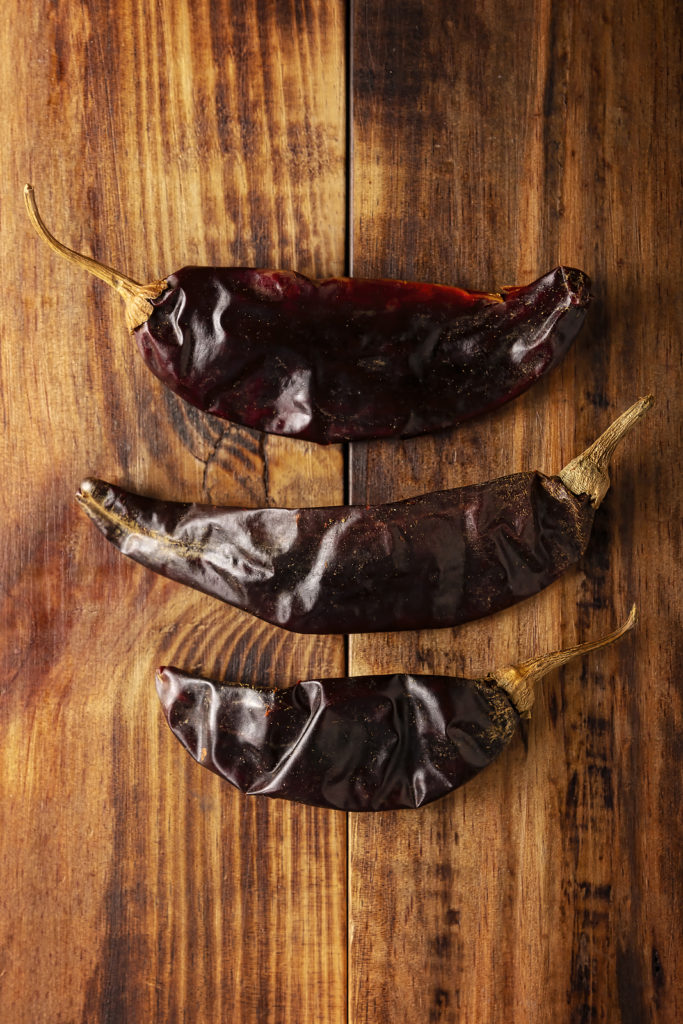
Medium hot peppers (from 2,500 to 5,000 SHU)
- Ancho 101. Mildly pungent (1,000-1,500 SHU). Heart-shaped, pointed, from 3 to 6 inches long, thin-walled; dark green turning red at maturity. Grows best where the weather is in the 70°sF. This tall plant may require staking. Use for chiles rellenos.
- Cascabel. Moderately pungent, spicy flavor (1,500-2,500). Cherry-type, spherical, shiny fruit to 1 inch in diameter; dark green turning deep red at maturity; medium thin walls. The plant grows to 36 inches tall. Grows well in moderate climates. Pods rattle when dry. Grind dry pods into powder to flavor fish and shrimp.
- Guajillo. Biting hot. Large, tapered fruit to 5½ inches long to 1 inch in diameter; turns translucent red when ripe; thin-walled. The plant grows to 36 inches tall. Good for drying. 58 to 90 days to maturity. Has a fruity flavor; used in red enchilada sauce.
- Hungarian Rainbow Wax. Semi-hot flavor. Blocky, thick-fleshed fruit with 3 to 4 lobes; light yellow to a rainbow of sunset colors to red when fully ripe. Use for relishes and salsas. 62 days to maturity.
- Hungarian Wax. Medium hot. Pods are 6 to 8 inches long; bright red at maturity. The plant grows to 24 inches tall. 70 days to maturity.
- NuMex Mirasol. (2,500-5,000 SHU). Pods are 3 to 4 inches long ½ to ¾ inches wide; grow to 24 inches tall with multiple stems and branches and clusters of fruit at the end of each branch. 90 days to maturity. Used in dry, red form as a chile powder.
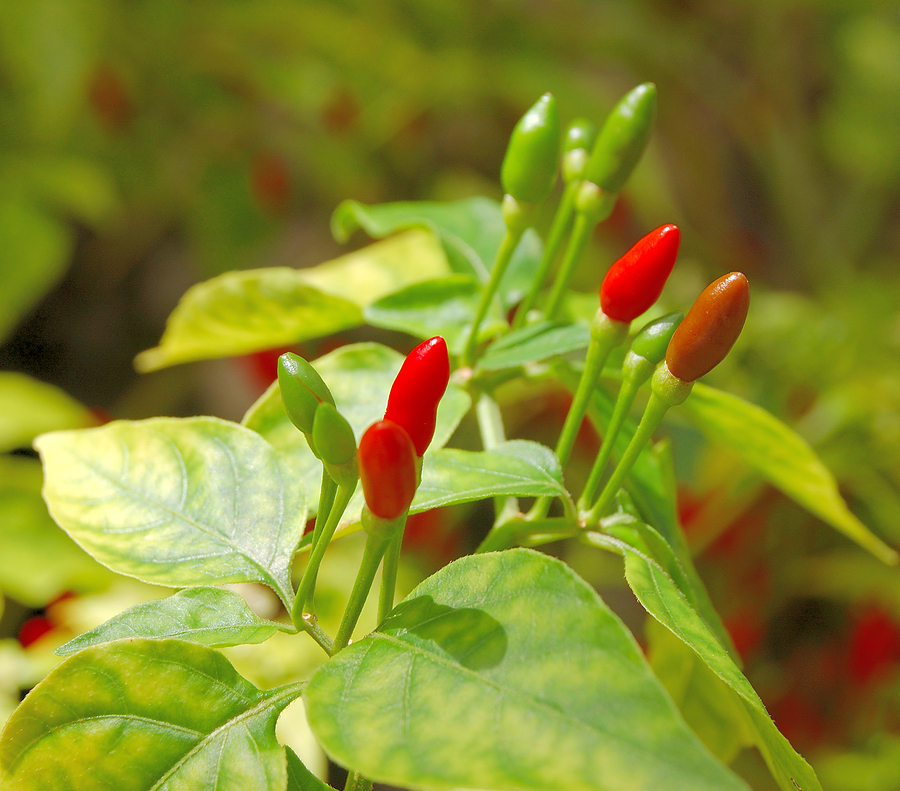
Fiery hot peppers (from 5,000 to 500,000 SHU)
- Aji. Very hot (5,000-15,000 SHU). Pods 3 to 5 inches long; orange-red at maturity. Use in sauces and stews.
- Bhut jolokia. (1 million SHU). Also known as ghost pepper, is said to be the hottest chili pepper in the world.
- Dr. Greenleaf Red Hot Tabasco. Very pungent (5,000-15,000 SHU). Heavy cropping, virus resistant. 120 days to maturity.
- Fresno Grande. Very pungent. Improved Fresno type; small, conical fruit tapering to a point, to 3 inches long; medium green turning to bright red when ripe; medium thick-walled. The plant grows to 24 inches tall.
- Habañero. Hottest pepper (100,000-500,000 SHU). Square to heart-shaped fruit, often wrinkled, to 2½ inches long, 1 inch wide; light-green turning orange or red at maturity. Requires a long, hot, humid growing season. Use fresh in salsas or fermented to make hot sauce.
- Jalapeño. Very pungent (5,000-15,000). Sausage-shaped fruit tapering to a blunt end, about 3 inches long, 1½ inches in diameter; deep-green turning bright red when ripe; medium-thick walls. 75 days to maturity. Use as a spice and condiment, as an ingredient in salsa.
- Large Red Thick (Charleston Cayenne). Spicy; hotter than Jalapeno. Pods are 5 to 10 inches long, ½ to 1 inch wide, and crescent, or irregular in shape. Large Red Thick is grown in the West; Charleston Cayenne is grown in the Southeast. Often ground into flakes for pizza.
- Long Red Slim Cayenne. Very pungent. Long, slender fruit tapered to a point, to 7 inches long and ½ inch wide, often wrinkled; dark green ripening to bright red. The plant grows to 24 inches tall. High-yielding plant. 72 days to maturity.
- Louisiana Hot. Very hot. Elongated, tapered fruit to 4 inches long; green turning red at maturity. Heirloom variety.
- Peter Pepper. Very pungent. Fruit to 4 inches long, 1½ inches wide, named for its penis shape; turning red when ripe. Use for pickling when green; dries well. The plant grows to 24 inches tall; very prolific.
- Pretty Purple Pepper. Extremely hot. Dark purple fruit turns red at maturity. The plant grows to 30 inches tall.
- Scotch Bonnet. Very hot (100,000-500,000). Shaped like a tam-o’-shanter; pods mature to yellow, red, or orange. Plants grow to 40 or more inches tall. Requires warm to hot growing season. Late maturing.
- Serrano. Very pungent (5,000-15,000 SHU). Slender, cylindrical fruit to 2 to 5 inches long, ½ inch in diameter, taper to blunt point; medium dark-green ripening to bright red; thin walls. The plant grows to 36 inches tall; highly productive. 80 days to maturity. Adapted to hot, humid climates. Use for salsa relish.
- Super Cayenne. Fiery flavor (30,000-50,000). Slightly curved fruit to 4 inches long; red when ripe. Use fresh dried. Compact plant to 24 inches tall. Good container plant. All America Selection. 70 days to maturity.
- Supper Chili. Very hot. Small, elongated, cylindrical fruit to 2½ inches long, ½ inch wide; pale-green turning red when ripe. Harvest from green to red stages. Upright plant. All-American selection. 70 days to maturity.
- Tabasco. Extremely hot (5,000-15,000). Small, slender pods 1 to 2 inches long, ¼ inch wide; yellow-green turning scarlet when ripe. Easy to grow; grow in containers. Used to make the Louisiana hot sauce.
- Thai Hot. Extremely pungent. Small, cone-shaped fruit 1 to 2½ inches long; very prolific. Compact plant. Reaches maturity in 40 days. Grows well in containers. Use pods in Asian dishes.
- Tiny Samoa. Very hot. Very small fruit, ⅛ inch thick and ½ inch long; green turning to red when ripe. Prolific producer. Can be grown in the house.
- Takanotsume Japanese. Sharply pungent. Pods to 2½ inches long, ¼ inch wide. Grow in most areas. 90 days to maturity. Dried and used in Asian soups.
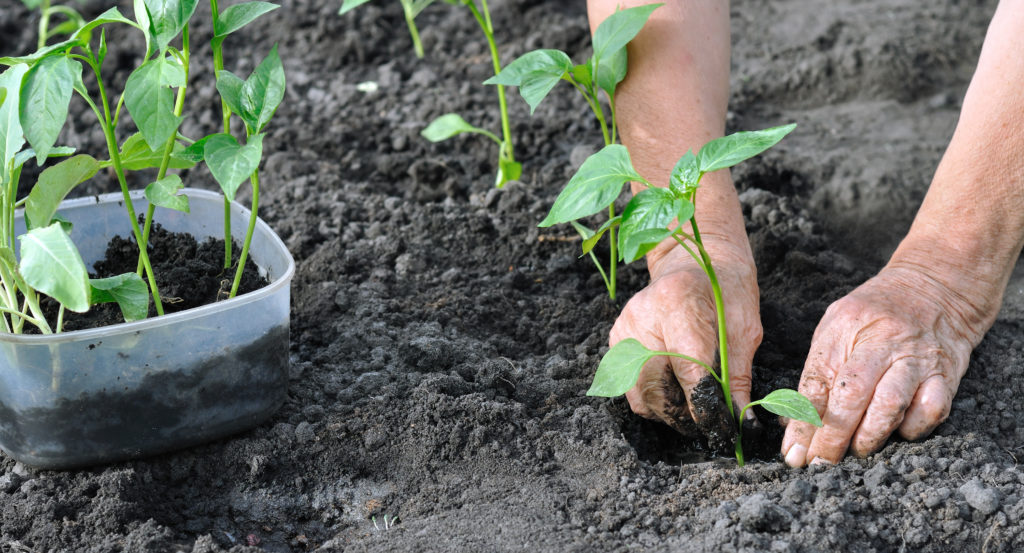
Where to plant hot peppers
Grow peppers in full sun in soil that is rich in organic matter, moisture retentive but well draining. Peppers prefer a soil pH of 5.5 to 6.8. Work aged garden compost into beds prior to planting. The optimal soil temperature for peppers is 65°F or warmer.
When to plant hot peppers
Hot peppers grow best in air temperatures of 70° to 95°F. Peppers are most easily grown from transplants. Start seed indoors 6 to 8 weeks before the date you intend to set peppers into the garden. Peppers can be seeded in the garden or transplanted out 2 to 3 weeks after the last frost in spring after the soil temperature has risen to at least 65°F. In temperatures greater than 85°F, peppers may drop their blossoms although set fruit will ripen. Hot peppers tolerate hot weather better than sweet peppers.
Planting and spacing hot peppers
Sow hot pepper seed ½ inch deep, 18 to 24 inches apart. Space rows 24 to 36 inches apart. Sow two seeds to each spot and thin to the most successful seedling. Peppers can be transplanted into the garden when they are 4 to 6 inches tall.
Container-growing hot peppers
Peppers can be grown in a large container. An 8-inch pot will accommodate a single plant. In larger containers, set plants on 12-inch centers. Peppers can be grown indoors. Pepp
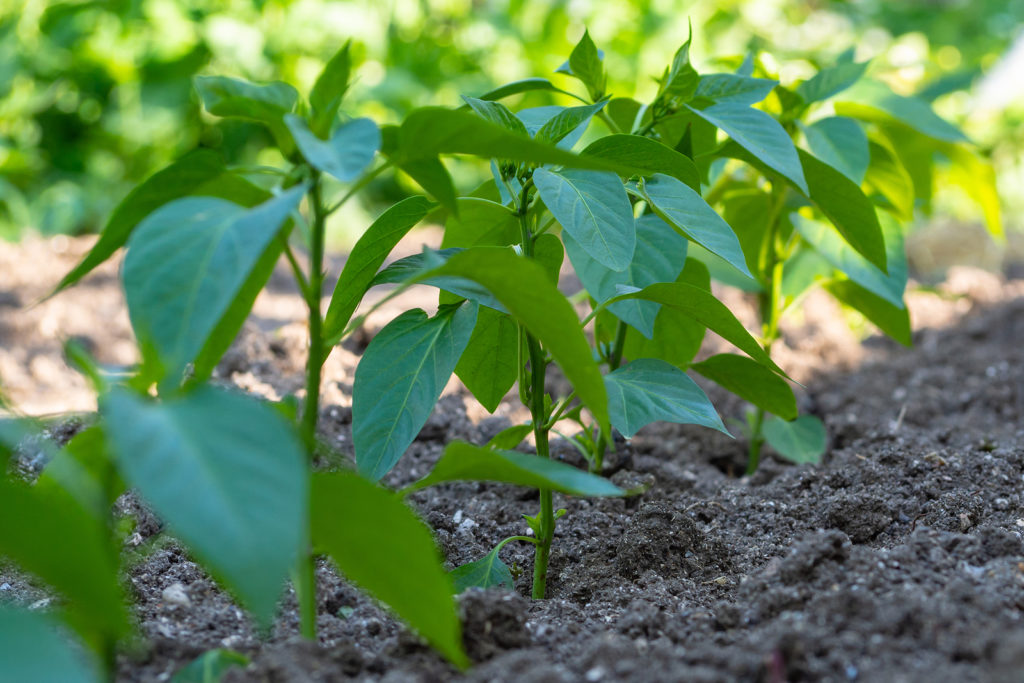
Water and feeding hot peppers
Keep peppers evenly moist but not wet particularly when blossoms appear and fruit begins to form. Soil that goes too dry can result in flower drop. Add aged compost to planting beds before planting and again at midseason. Water more frequently after the fruit forms. Water heavily 4 to 8 hours before harvest to turn hot peppers milder; withhold watering before harvest to make hot peppers hotter.
Hot pepper companion plants
Plant hot peppers with beets, garlic, onions, parsnips, and radishes.
Hot pepper care
Keep planting beds well-weeded to avoid competition. Peppers are shallow-rooted, so cultivate around peppers with care. Mulch to keep soil temperature and moisture even.
Feed peppers with phosphorus and potassium-rich fertilizer such as 5-10-10. Avoid high nitrogen fertilizers which will create large leafy plants with few or no fruits. High temperatures and wind can cause flowers to drop and plants not to set fruit.
Plastic mulch can improve pepper yields. Organic compost mulches will reduce weeding and watering, but not fruit yields.
Use shade cloth to protect peppers from sunburn if the temperature exceeds 105°F.
Good Products for Raised Bed Growing at Amazon:
- Galvanized Raised Bed 8×3
- Cedar Raised Bed 4×8
- Elevated Cedar Planter 4×2
- Walk-In Greenhouse Tunnel 15x7x7
- Row Cover for Freeze Protection 10×30
Hot pepper pests
Peppers can be attacked by aphids, cutworms, flea beetles, and hornworms. Discourage cutworms by placing a collar around each transplant at the time of planting; hand-pick hornworms off of plants. Flea beetles and aphids can be partially controlled by hosing them off the plants and pinching out infested foliage.
Hot pepper diseases
Peppers are susceptible to rot, blossom end rot, anthracnose, tobacco mosaic virus, bacterial spot, and mildew. Plant disease-resistant varieties. Keep the garden clean and free of weeds where pests and diseases can shelter. Remove infected plants before the disease can spread. If you smoke, wash your hands before working with the plants to avoid spreading the tobacco mosaic virus.

Harvesting hot peppers
Hot peppers are ready for harvest in 60 to 95 days after sowing. Pick hot peppers when they have reached full size and their mature color. Sweet peppers can be picked as soon as they reach any edible size; they can be picked and eaten green and do not have to reach mature color. Cut the peppers off the vine with a garden shear. Pulling a pepper away from the plant may cause the plant to come out of the soil.
Storing and preserving hot peppers
Hot peppers will keep in the refrigerator for 1 week or in a cool, dry spot for up to 2 weeks. Roasted and peeled hot peppers will keep in the freezer for up to 6 months. Pickle whole, cooked, and canned hot peppers will keep for up to 2 years.
When frost threatens, pick all of the fruit or pull up the plants and hang them upside down in a dry, cool place until the fruits ripen. You can also clip peppers off the plant–leaving an inch of stem on each pepper–and string them together to make ristras. Hang the ristra in a dry place and allow the peppers to dry. If you live in a humid region, a better way to dry peppers is to place a single layer at the bottom of a grocery bag and clip the bag shut. The peppers will dry–and not be susceptible to mold–in about 10 days.
About hot chili peppers
- Common name. Pepper, hot pepper, chili pepper
- Botanical name. Capsicum frutescens (hot pepper); Capsicum annuum (sweet and hot peppers)
- Origin. New World Tropics
More articles about pepper growing:
40 Chili Peppers to Grow in the Home Garden
How to Plant, Grow, and Harvest Peppers
Garden Planning Books at Amazon:
- Tomato Grower’s Answer Book
- Vegetable Garden Almanac & Planner
- Kitchen Garden Grower’s Guide Vegetable Encyclopedia
- Vegetable Garden Grower’s Guide
More how to grow articles:
Learn how to plant, grow, and harvest your favorite vegetables. Click below for all you need to know.
- Artichoke
- Arugula
- Asparagus
- Beans, Snap
- Beets
- Broad Beans
- Broccoli
- Brussels Sprouts
- Cabbage
- Cantaloupe — Melons
- Cardoon
- Carrots
- Cauliflower
- Celeriac
- Celery
- Chard
- Chayote Squash
- Chickpeas
- Chicory
- Chinese Cabbage
- Collards
- Corn Salad
- Corn, Sweet
- Cresses
- Cucumbers
- Eggplant
- Endive and Escarole
- Fava Beans
- Florence Fennel
- Garbanzo Beans
- Garlic
- Horseradish
- Jerusalem Artichoke
- Kale
- Kohlrabi
- Leeks
- Lettuce
- Lima Beans
- Melons
- Mizuna
- Mustard Greens
- New Zealand Spinach
- Okra
- Onions
- Parsnips
- Peanuts
- Peas
- Peppers
- Potatoes
- Pumpkins
- Radicchio
- Radishes
- Rhubarb
- Rutabaga
- Salsify
- Shallots
- Sorrel
- Southern Peas
- Soybeans
- Spinach
- Squash, Summer
- Squash, Winter
- Sunchokes
- Sweet Potato
- Swiss Chard
- Taro
- Tomatillo
- Tomatoes
- Turnips
- Watermelon
- Zucchini















